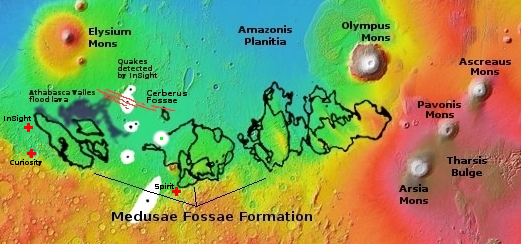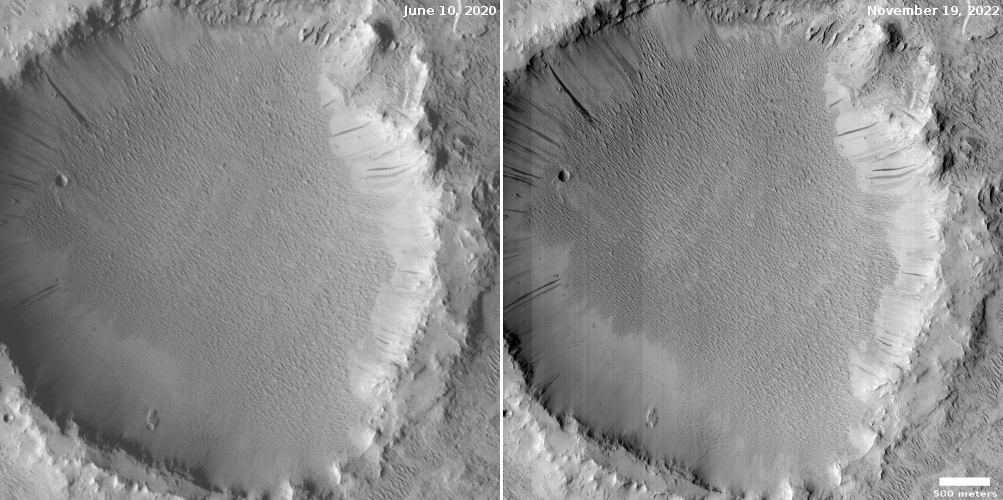Searching for surface changes caused by the biggest recorded Martian quake

The white patches mark the locations on Mars of the largest quakes detected by InSight
On May 4, 2022, the seismometer on the InSight Mars lander detected a 4.7 magnitude earthquake on Mars, the largest ever detected.
The map to the right shows the approximate location of that quake by the white patch with the green dot. (You can read the paper describing this quake here [pdf].) This is also the same approximate location of a small five-mile-wide crater known to have many slope streaks on its interior walls.
Slope streaks are a uniquely Martian geological feature whose origin remains unknown. They resemble dark avalanche streaks flowing downhill, but make no changes in the topography, and lighten with time. They also occur randomly throughout the year. Two slightly different theories for their formation suggest that the streaks are triggered by the fall of dust particles, though neither is proven or even favored.
If either of these theories are true, then the 4.7 magnitude earthquake at this location should have caused the formation of more streaks. To find out, scientists have used the high resolution camera on Mars Reconnaissance Orbiter (MRO) to compare that crater both before and after the quake to see if any new streaks has appeared. Below is a side-by-side comparison of these images.

For the original images go here and here.
The picture on the left was taken by MRO’s context camera on June 10, 2020. Though its resolution is much less than MRO’s high resolution camera, for this purpose it is good enough. I have also enhanced it to make it better match the high resolution picture on the right, taken on November 19, 2022. Both pictures have been rotated, cropped and reduced to post here.
A close look at both pictures shows little or no change. Either slope streaks are not caused by dust avalanches, or the quake was simply not large enough to shake any dust avalanches loose.
One caveat: Both images above are based on the full resolution pictures provided to the public. Higher resolution versions are also available, but in a specialized format. It is possible that when the scientists review these images in those higher resolutions, they might detect changes not visible above.
On Christmas Eve 1968 three Americans became the first humans to visit another world. What they did to celebrate was unexpected and profound, and will be remembered throughout all human history. Genesis: the Story of Apollo 8, Robert Zimmerman's classic history of humanity's first journey to another world, tells that story, and it is now available as both an ebook and an audiobook, both with a foreword by Valerie Anders and a new introduction by Robert Zimmerman.
The print edition can be purchased at Amazon or from any other book seller. If you want an autographed copy the price is $60 for the hardback and $45 for the paperback, plus $8 shipping for each. Go here for purchasing details. The ebook is available everywhere for $5.99 (before discount) at amazon, or direct from my ebook publisher, ebookit. If you buy it from ebookit you don't support the big tech companies and the author gets a bigger cut much sooner.
The audiobook is also available at all these vendors, and is also free with a 30-day trial membership to Audible.
"Not simply about one mission, [Genesis] is also the history of America's quest for the moon... Zimmerman has done a masterful job of tying disparate events together into a solid account of one of America's greatest human triumphs."--San Antonio Express-News

The white patches mark the locations on Mars of the largest quakes detected by InSight
On May 4, 2022, the seismometer on the InSight Mars lander detected a 4.7 magnitude earthquake on Mars, the largest ever detected.
The map to the right shows the approximate location of that quake by the white patch with the green dot. (You can read the paper describing this quake here [pdf].) This is also the same approximate location of a small five-mile-wide crater known to have many slope streaks on its interior walls.
Slope streaks are a uniquely Martian geological feature whose origin remains unknown. They resemble dark avalanche streaks flowing downhill, but make no changes in the topography, and lighten with time. They also occur randomly throughout the year. Two slightly different theories for their formation suggest that the streaks are triggered by the fall of dust particles, though neither is proven or even favored.
If either of these theories are true, then the 4.7 magnitude earthquake at this location should have caused the formation of more streaks. To find out, scientists have used the high resolution camera on Mars Reconnaissance Orbiter (MRO) to compare that crater both before and after the quake to see if any new streaks has appeared. Below is a side-by-side comparison of these images.

For the original images go here and here.
The picture on the left was taken by MRO’s context camera on June 10, 2020. Though its resolution is much less than MRO’s high resolution camera, for this purpose it is good enough. I have also enhanced it to make it better match the high resolution picture on the right, taken on November 19, 2022. Both pictures have been rotated, cropped and reduced to post here.
A close look at both pictures shows little or no change. Either slope streaks are not caused by dust avalanches, or the quake was simply not large enough to shake any dust avalanches loose.
One caveat: Both images above are based on the full resolution pictures provided to the public. Higher resolution versions are also available, but in a specialized format. It is possible that when the scientists review these images in those higher resolutions, they might detect changes not visible above.
On Christmas Eve 1968 three Americans became the first humans to visit another world. What they did to celebrate was unexpected and profound, and will be remembered throughout all human history. Genesis: the Story of Apollo 8, Robert Zimmerman's classic history of humanity's first journey to another world, tells that story, and it is now available as both an ebook and an audiobook, both with a foreword by Valerie Anders and a new introduction by Robert Zimmerman.
The print edition can be purchased at Amazon or from any other book seller. If you want an autographed copy the price is $60 for the hardback and $45 for the paperback, plus $8 shipping for each. Go here for purchasing details. The ebook is available everywhere for $5.99 (before discount) at amazon, or direct from my ebook publisher, ebookit. If you buy it from ebookit you don't support the big tech companies and the author gets a bigger cut much sooner.
The audiobook is also available at all these vendors, and is also free with a 30-day trial membership to Audible.
"Not simply about one mission, [Genesis] is also the history of America's quest for the moon... Zimmerman has done a masterful job of tying disparate events together into a solid account of one of America's greatest human triumphs."--San Antonio Express-News


With more seismographs, pinpointing Marsquakes locations and recording frequency and depth will tell us much about the internal structure of Mars.
In my head I picture “rods of God” dropping from space in a regular pattern across Mars. Tungsten tipped hollow rods ejected from military style launch tubes at Mars before entering orbit. Timed at regular intervals to have great coverage across the surface.
After impact, solar panels mounted on wide spring steel (like measuring tape) Will unfurl giving power and communication for the seismic/temperature package buried in the earth. I mean dirt… If it doesn’t hit a rock.
A few extra tubes can be added, in case some do not report back in, that can be ejected to those locations before payload carrier impacts the surface to test the seismic data. It will give it a baseline for known weight and impact speed.
A tagalong separate package for lighter than air experimentation… A cell phone sized instrument package covered in button cameras, Rangefinder, temperature, altimeter etc. to drop to near the surface by thin solar panel covered Mylar parachute which will fill with helium on dissent and be carried by the wind around Mars for years.
In low air pressure Mars, helium leakage will be slow… should last a long time. A larger balloon can hold small canisters (like CO2 cartridges) that can refill balloon and drop off (like ballast) to make mission last longer.
If it works out, larger balloon packages with other instrumentation like air/water sampler‘s and detachable drones with steering capabilities can be programmed to search out places of interest. Perhaps take a scoop of the “slope streaks“ to take back to a sample digester for analysis.
Remember when the Russians crashed a probe on Phobos? I don’t know why I’m thinking of that.